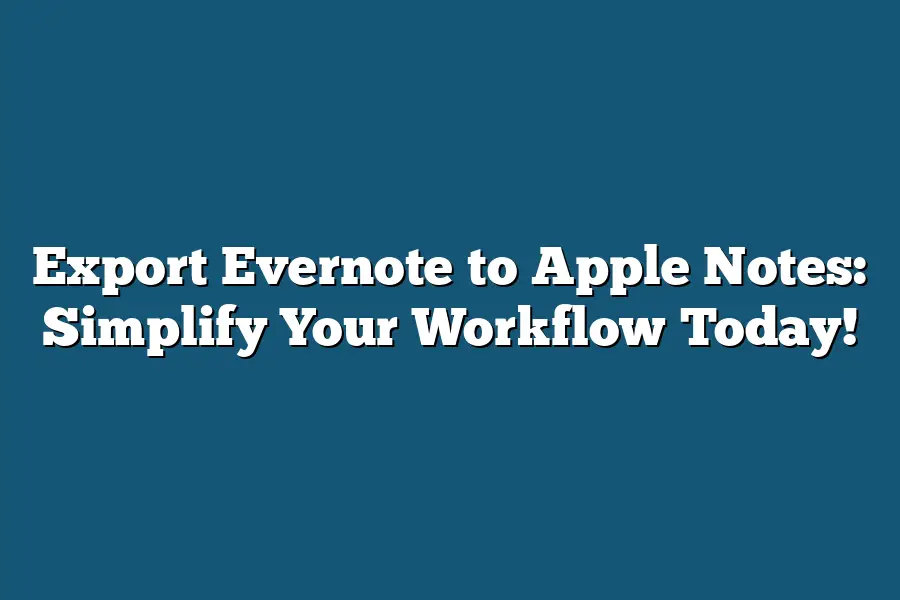To export Evernote notes to Apple Notes, you can follow these steps. First, make sure you have both Evernote and Apple Notes apps installed on your device. Then, open Evernote and select the note(s) you want to export by checking the box next to each note. Finally, go to “File” > “Export” and choose “Apple Notes (.nnotes)” as the file format.
As someone who’s obsessed with streamlining my workflow and maximizing productivity, I’ve always been fascinated by the power of note-taking apps.
For years, I’ve relied on Evernote to store my thoughts, ideas, and tasks, but recently, I made the switch to Apple Notes – and it’s been a game-changer.
One of the biggest challenges I faced was figuring out how to seamlessly export my data from Evernote to Apple Notes.
It wasn’t easy, folks!
But after hours of experimentation and research, I finally cracked the code.
In this post, I’ll walk you through the process of exporting your notes from Evernote to Apple Notes, including the types of data you can transfer, step-by-step instructions, and some valuable tips for organizing your workflow.
Whether you’re a die-hard Evernote fan or an Apple Notes convert like me, you’ll learn how to unlock the full potential of both apps and supercharge your productivity.
Table of Contents
Understanding the Basics: Exporting from Evernote to Apple Notes
I’m sure you’re eager to simplify your workflow and get those notes out of Evernote and into Apple Notes.
But before we dive in, let’s take a step back and understand the export process.
Think of exporting as moving all your precious notes from one home (Evernote) to another (Apple Notes).
It’s crucial to grasp how this works to ensure a seamless transition.
Otherwise, you might end up with fragmented data, lost tags, or worse – a complete note-astrophe!
So, what can be exported?
You guessed it – all sorts of goodies!
Here are the types of data you can move from Evernote to Apple Notes:
- Notes: The main event! Export individual notes or entire notebooks. This includes text, images, audio recordings, and even handwritten notes (if you’re using a stylus).
- Notebooks: Organize your notes into neatly labeled folders in Apple Notes. You can export entire notebooks or specific sections within.
- Tags: Don’t lose those carefully crafted tags! Export them to maintain consistency across both platforms.
Now that we’ve covered the basics, let’s get down to business.
Follow these step-by-step instructions to export from Evernote to Apple Notes:
Step 1: Create a New Notebook in Apple Notes
Fire up Apple Notes and create a new notebook to receive your exported data.
Give it a descriptive name, like “Evernote Archives” or “Notes Migration.” This will serve as the landing pad for your exported notes.
Step 2: Set Up the Export Options in Evernote
In Evernote, navigate to the note or notebook you want to export.
Click on the three vertical dots (⋯) next to the note title and select Export.
You’ll be presented with a range of options:
- Notebooks: Choose the notebooks you want to export.
- Tags: Select specific tags or use the “All” option to export all tagged notes.
- Notes: Pick individual notes or use the “All” option for an entire notebook.
Step 3: Export the Desired Data
Once you’ve selected your export options, click Export.
You’ll be prompted to choose a file format:
- ENEX (Evernote Export): A proprietary file type for Evernote data.
- HTML: For those who prefer a web-based export.
Choose the desired format and select a location on your computer to save the exported files.
After the export is complete, you can now import these files into Apple Notes.
To do so:
- Open Apple Notes and create a new note or notebook (if you haven’t already).
- Tap the + icon in the top-right corner and select Import from File.
- Choose the exported file (ENEX or HTML) and follow the on-screen instructions.
That’s it!
Your notes are now safely migrated to Apple Notes, ready for your next workflow adventure.
Stay tuned for more tips and tricks to simplify your note-taking experience across both platforms.
Tips for Seamless Integration: Organizing Your Workflow
As you’re probably aware, switching from Evernote to Apple Notes can be a bit of an adjustment.
But with the right strategies in place, you can make the transition smoother than a summer breeze on a hot day.
In this section, we’ll dive into some essential tips and best practices for organizing your workflow across both platforms.
Consistency is Key: Naming Conventions
When it comes to naming conventions for notebooks and tags, consistency is crucial.
You don’t want to be stuck searching through a sea of random notes and tags, trying to find that one specific piece of information.
Instead, adopt a naming convention that works for you.
For example:
- Use a prefix like “ER_” for Evernote-related notes or “AN_” for Apple Notes-specific ones
- Designate notebooks by project or topic (e.g., “Marketing Campaign” vs. “Personal Finance”)
- Keep tags concise and focused on the note’s content (e.g., “#todo”, “#research”, etc.)
By implementing a consistent naming convention, you’ll save time in the long run and make it easier to find what you need.
Tagging Like a Pro: Categorize and Search
Tags are an underutilized feature in both Evernote and Apple Notes.
By using them correctly, you can turn your notes into a searchable database that’s just waiting to be mined for insights.
Here are some tagging best practices:
- Use action-oriented tags like “#todo”, “#done”, or “#research” to categorize tasks and projects
- Create descriptive tags based on the note’s content (e.g., “#marketing”, “#productivity”, etc.)
- Avoid using generic tags like “note” or “idea” – be more specific!
By leveraging tags effectively, you’ll be able to quickly find related notes and topics, making it easier to work across both platforms.
Notebooks for Success: Project-Based Organization
Notebooks are an essential organizational tool in both Evernote and Apple Notes.
Here’s how to use them like a pro:
- Designate notebooks by project or topic (e.g., “Marketing Campaign” vs. “Personal Finance”)
- Use tags within notebooks to further categorize and search notes
- Create separate notebooks for different projects or topics, keeping related information organized
By using notebooks effectively, you’ll be able to easily find and access specific information, streamlining your workflow.
And that’s it!
By following these tips and best practices, you’ll be well on your way to a seamless integration of Evernote and Apple Notes.
Remember, consistency, tagging, and notebook organization are the keys to unlocking a more productive you.
Advanced Techniques: Using Apple Notes’ Features with Your Exported Evernote Data
As you’ve already made the smart move by exporting your Evernote notes to Apple Notes, it’s time to unleash the true power of this note-taking app.
In this section, we’ll dive into some advanced techniques that will help you streamline your workflow and get the most out of your exported data.
Creating Custom Note Types: Meeting Notes, To-Do Lists, and More
One of the most underutilized features in Apple Notes is its ability to create custom note types.
This means you can categorize your notes into different categories, making it easy to find specific information later on.
For example, you could create a “Meeting Notes” note type for all your meeting summaries, or a “To-Do Lists” note type for all the tasks you need to complete.
By creating custom note types, you’ll be able to:
- Quickly identify the type of note as you scroll through your notes list
- Use the search function to find specific note types
- Organize your notes in a way that makes sense to you
Using the “Add to Notebook” Feature: Easy Organization
When you export your Evernote notes to Apple Notes, you’ll have a ton of individual notes.
But what if you want to organize these notes into notebooks or sections?
That’s where the “Add to Notebook” feature comes in.
This feature allows you to add multiple notes to a single notebook with just a few taps.
No more tedious copying and pasting or creating new notebooks for each note!
Here are some scenarios where using the “Add to Notebook” feature can be super helpful:
- You’ve taken notes during a meeting, and you want to add them all to one notebook
- You’re working on a project, and you need to keep all related notes in one place
- You’re tracking a specific topic or theme, and you want to collect all relevant notes in one notebook
Taking Advantage of Apple Notes’ Collaboration Features
One of the biggest advantages of using Apple Notes is its collaboration features.
With these features, you can share your notes with others, allowing you to work together more effectively.
Here are some ways you can use Apple Notes’ collaboration features:
- Share a notebook with a team member or colleague, and let them contribute to it
- Create a shared notebook for a project or meeting, where everyone involved can add their thoughts and ideas
- Use the “Add to Notebook” feature to add notes from multiple people to one notebook, making it easy to track progress
By leveraging these collaboration features, you’ll be able to:
- Work more efficiently with others
- Get feedback and input from team members or colleagues
- Stay organized and on top of your work
And that’s it for today!
By mastering these advanced techniques in Apple Notes, you’ll be able to streamline your workflow, get the most out of your exported data, and stay organized.
In our next section, we’ll explore more ways to optimize your note-taking experience with Apple Notes.
Final Thoughts
In this post, we’ve explored the world of exporting Evernote data to Apple Notes.
Whether you’re a die-hard fan of Evernote or a convert from the dark side (Apple Notes), it’s essential to understand how to export your notes seamlessly.
By following the steps outlined in this post, you’ll be able to simplify your workflow and enjoy the benefits of having both tools at your fingertips.
Personally, I’ve found that having a streamlined workflow between Evernote and Apple Notes has been a game-changer for my productivity.
The ability to access my notes across multiple devices and platforms has given me the flexibility to work from anywhere – a true blessing for anyone who loves working remotely!
By applying the tips and techniques shared in this post, you’ll be well on your way to achieving a seamless integration between Evernote and Apple Notes.
So, what are you waiting for?
Start exporting your notes today and unlock the full potential of your note-taking workflow!


